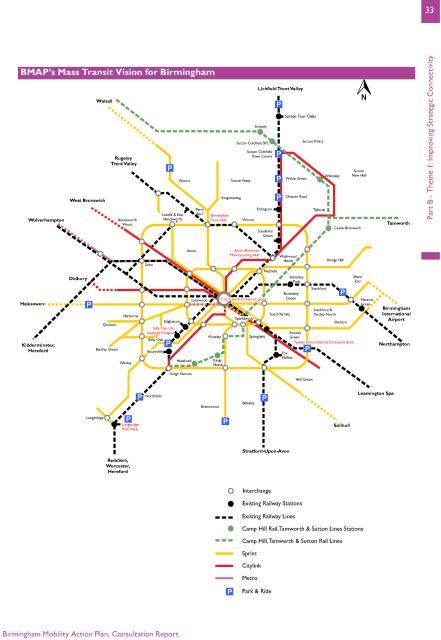Steve Beauchampé comments on yesterday’s announcement of plans for Birmingham transport.
Birmingham City Council and Centro’s newly published 25-year public transport Mobility Action Plan appears at first sight to have much to commend it, and initial reaction has been positive. The proposals, which are now subject to public consultation, prioritise public transport, walking and cycling over private motoring. They include the re-instatement of commuter trains on both the Sutton Coldfield-King’s Norton and Bordesley Chords rail lines, solar and electric powered buses and a network of 11 ‘Sprint’ rapid bus lines, a more joined up ticketing strategy permitting more passengers to switch between different modes of transport whilst using the same ticket, and partial closure of the A38 Queensway tunnels to cars.
Although it is this final proposal that has garnered much of the media coverage, just as noteworthy is the absence of any city-scale tram network, the abandonment of a long-held dream of many in both the council and Centro. If the 0.9 mile, £60 million Line 1 city centre extension (scheduled to open in 2015, 17 years after the service first began operating) is any guide, we calculate that constructing a city-wide network would have cost several billion pounds and be completed sometime around the year 2989. Blimey, we could all be dead by then!
Given such an admission of failure as regards Metro it seems absurd that the plan includes provision to extend Line 1 from the recently approved Centenary Square terminus to the Hagley Road, especially when Snow Hill Station/Colmore Row to Five Ways and beyond is already served by numerous bus routes. (https://thebirminghampress.com/2013/10/metro-road-to-nowhere/)
As for the overall plan, it is perhaps advisable to remain cautious. Track 65, the Moor Street Queensway bus mall, bendy-buses, red routes, the half-hearted introduction of bus lanes – so many previous public transport initiatives have failed or at best only partially succeeded, with the result that car journeys now make up around 50% of city centre commuting compared to a figure as low as 15% in such places as Stockholm and Osaka. Add above inflation annual fare increases, the purchase of poorly designed, single decker buses (more standing spaces, fewer seats, inadequate air conditioning, multiple level floors and a lack of headroom towards the rear) and the recent introduction of arguably the worst designed bus shelters imaginable (providing little shelter and no usable seating), the closure of lower Corporation Street and it is no surprise that the number of bus journeys has been falling alarmingly in recent years.
The Sprint bus network plan may prove controversial (as it will likely reduce space for cars on most of the city’s arterial roads with buses taking up two centre lanes) but is at least worthy of serious investigation. To succeed it will require cross-party political support, something that may be hard both to achieve and maintain. If implementation results in loss of central reservations and large numbers of trees, then opposition will be guaranteed. Furthermore, while it may be possible to operate permanent bus lanes along parts of the Bristol and Hagley roads, Stratford, Soho and Coventry roads, already effectively operating as two lane highways for significant parts of their length, may prove way more problematic.
Finally (for now) there is the question of funding the various schemes outlined in the Mobility Action Plan. Although some monies might be accessed or raised locally, with Britain arguably the most centrally-run country in Europe, Birmingham will as ever be forced to make its case to Whitehall to finance most of the proposals. Reason enough therefore to think carefully about these ideas and improve them where necessary.
